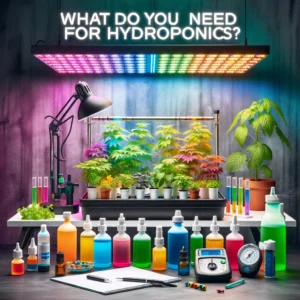
What do you need for hydroponics?
If you’re fascinated by the idea of growing plants without soil, hydroponics offers an exciting solution. This innovative method uses a nutrient-rich water solution to deliver all the essential elements your plants need to thrive. With hydroponics, you can enjoy faster growth rates, greater yields, and the ability to grow food year-round, even in limited spaces.
But how do you get started with this soil-free growing technique? The good news is that setting up a basic hydroponic system is simpler than you might think. From reservoirs to nutrient solutions, there are a few essential components you’ll need to gather before you embark on your hydroponic adventure.
Let’s dive into the key things you’ll need to kickstart your hydroponic journey. By understanding the basic equipment, you’ll be well on your way to reaping the many benefits of this rewarding growing method.
Essential Components of a Hydroponic System
Let’s break down the fundamental elements you’ll need to build your hydroponic garden:
Growing Medium
- Unlike traditional gardening, hydroponic plants don’t rely on soil for support. Instead, a growing medium provides stability and a place for roots to anchor. Common options include:
- Rockwool: Porous cubes that retain moisture well.
- Clay pebbles (Hydroton): Reusable and provide ample aeration.
- Coco coir: Sustainable and offers good water retention.
- Perlite: Promotes drainage and air circulation.
Net Pots
- These mesh pots are designed to hold your plant and its chosen growing medium. The openings in the mesh allow roots to grow freely into the nutrient solution below.
Reservoir
- This is the heart of your hydroponic system – a container that holds your nutrient-infused water. Choose an opaque reservoir to minimize light exposure, which can promote unwanted algae growth.
Nutrient Solution
- Hydroponic plants can’t extract nutrients from soil, so you’ll need a specialized fertilizer formulated for soilless growing. These solutions contain all the essential macro and micronutrients your plants need to thrive.
Water Pump (for some systems)
- Systems like Deep Water Culture (DWC) or Nutrient Film Technique (NFT) benefit from a water pump to circulate the nutrient solution and ensure that roots have constant access to oxygen and nutrients.
Air Pump and Air Stone (for some systems)
- If your roots are fully submerged (like in DWC), an air pump and air stone are vital. They oxygenate the nutrient solution, preventing root rot and promoting healthy growth.
Additional Equipment
Beyond the core components, here’s some additional equipment that will enhance your hydroponic gardening experience:
Lighting
- Plants need ample light to photosynthesize and grow. If you’re growing indoors, you’ll need to invest in suitable grow lights. LED grow lights are popular choices due to their energy efficiency and the ability to customize the light spectrum for optimal plant growth. Consider factors like the size of your growing space and the types of plants you intend to grow when choosing lights.
pH Meter ‘
- The pH level of your nutrient solution significantly impacts nutrient availability for your plants. A pH meter helps you monitor and adjust the pH to ensure it remains within the optimal range for your specific crops. Most plants thrive in a slightly acidic pH range (between 5.5 and 6.5).
EC Meter
- An EC meter (Electrical Conductivity meter) allows you to measure the concentration of dissolved nutrients in your solution. This helps you avoid over-fertilizing or under-fertilizing your plants, ensuring they have the right balance of nutrients.
Choosing a Hydroponic System
The world of hydroponics offers a variety of systems, each with its advantages and complexities. As a beginner, it’s wise to choose a system that is relatively simple to set up and maintain. Here’s a brief overview of some popular options:
Deep Water Culture (DWC)
- A straightforward system where plant roots are suspended in a well-oxygenated nutrient solution. DWC is easy to set up and low-maintenance.
Kratky Method
- A remarkably simple and passive hydroponic system. Plants are suspended above a nutrient solution reservoir, and as the water level drops, an air gap develops, providing aeration to the roots.
Nutrient Film Technique (NFT)
- Here, plants are grown in slightly angled channels with a continuous flow of shallow nutrient solution. NFT systems are efficient but require a bit more setup than DWC or Kratky.
Drip irrigation
- Similar to traditional soil-based drip irrigation, this system delivers a nutrient solution directly to the base of plants. It’s adaptable for various grow mediums.
If you don’t want to think about choosing a system, let me help you out. I recommend the Farmstand and Growace Complete Grow Kit. Both are great system and come with everything you need to get started. They take out all the “well I think I forgot about this, or that.” They just straight up send you everything. It is worth the investment if you are on the market, and they are friends of ours.
To Sum it Up
Starting your hydroponic journey is an exciting step! By understanding the required equipment and exploring the different types of systems, you’ll be well-equipped to choose the setup that best suits your needs, space, and budget. Remember, hydroponics is a rewarding learning process. Don’t be afraid to experiment, start small, and most importantly, enjoy the experience of growing your own food using this innovative method.
If you’re ready to dive deeper, there’s a wealth of online resources, forums, and communities dedicated to hydroponics, where you can find support, inspiration, and share your successes.

